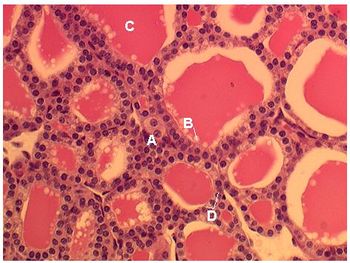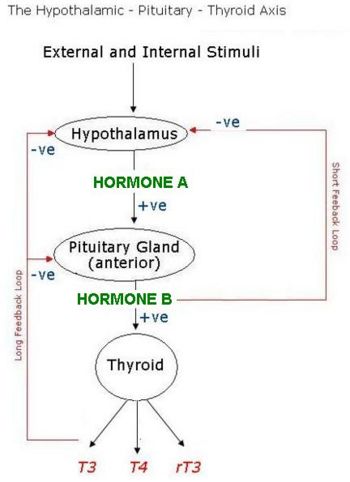Difference between revisions of "Thyroid Gland Flash Cards - Anatomy & Physiology"
Jump to navigation
Jump to search
m |
|||
| (6 intermediate revisions by 2 users not shown) | |||
| Line 1: | Line 1: | ||
| − | |||
| − | |||
| − | |||
| − | |||
| − | |||
| − | |||
| − | |||
| − | |||
| − | |||
<FlashCard questions="10"> | <FlashCard questions="10"> | ||
|q1=Describe embryological origin of the Thyroid Gland. | |q1=Describe embryological origin of the Thyroid Gland. | ||
| Line 19: | Line 10: | ||
|q3=Describe the blood supply and venous drainage of the Thyroid Gland. | |q3=Describe the blood supply and venous drainage of the Thyroid Gland. | ||
|a3= | |a3= | ||
| − | *Supply | + | *Supply: Cranial Thyroid Artery and Caudal Thyroid Artery |
| − | *Venous Drainage | + | *Venous Drainage: Thyroid Vein (leading to Internal Jugular Vein). |
|l3=Thyroid Gland - Anatomy & Physiology | |l3=Thyroid Gland - Anatomy & Physiology | ||
|q4=The Thyroid gland consists of various sized follicles. What is the name of the cells which line the lumen of the follicles, and what is their function? | |q4=The Thyroid gland consists of various sized follicles. What is the name of the cells which line the lumen of the follicles, and what is their function? | ||
|a4=Follicular Cells - these synthesize thyroglobulin in their golgi apparatus. Thyroglobulin is a glycoprotein consisting of 70 linked ''tyrosine'' molecules and is the source of thyroid hormones. | |a4=Follicular Cells - these synthesize thyroglobulin in their golgi apparatus. Thyroglobulin is a glycoprotein consisting of 70 linked ''tyrosine'' molecules and is the source of thyroid hormones. | ||
|l4=Thyroid Gland - Anatomy & Physiology | |l4=Thyroid Gland - Anatomy & Physiology | ||
| − | |q5=Label the following histological section: | + | |q5=Label the following histological section: (Image 1 below) |
| − | |||
|a5= | |a5= | ||
| − | *A | + | *A - Connective Tissue Capsule |
| − | *B | + | *B - Thyroid Follicles |
| − | *C | + | *C - Connective Tissue Septum |
| − | *D | + | *D - Blood Vessels in Capsule. |
|l5=Thyroid Gland - Anatomy & Physiology#Histology Gallery | |l5=Thyroid Gland - Anatomy & Physiology#Histology Gallery | ||
|q6=Which Letter represents the location of the C-Cells of the Thyroid Gland, and what is their function in 'Image 1' below? | |q6=Which Letter represents the location of the C-Cells of the Thyroid Gland, and what is their function in 'Image 1' below? | ||
| Line 41: | Line 31: | ||
|a7= | |a7= | ||
*Iodide trapping is the process by which Iodide molecules (I-) are concentrated in the colloid at a level up to 250x greater than the plasma level. | *Iodide trapping is the process by which Iodide molecules (I-) are concentrated in the colloid at a level up to 250x greater than the plasma level. | ||
| − | *The Na+/I- symport in the basal membrane of the follicular cells moves the iodine from the plasma, into the cell. From here | + | *The Na+/I- symport in the basal membrane of the follicular cells moves the iodine from the plasma, into the cell. From here it is transported into the colloid. |
*The follicular cells and the pumps function in response to Thyroid Stimulating Hormone from the Pituitary Gland. | *The follicular cells and the pumps function in response to Thyroid Stimulating Hormone from the Pituitary Gland. | ||
|l7=Thyroid Gland - Anatomy & Physiology#Iodine Uptake | |l7=Thyroid Gland - Anatomy & Physiology#Iodine Uptake | ||
| Line 51: | Line 41: | ||
|q9=What are Hormone A and Hormone B in this schematic diagram ('Image 2' below) of the Hypothalamic - Pituitary - Thyroid Axis: | |q9=What are Hormone A and Hormone B in this schematic diagram ('Image 2' below) of the Hypothalamic - Pituitary - Thyroid Axis: | ||
|a9= | |a9= | ||
| − | *Hormone A | + | *Hormone A: TRH - Thyrotropin Releasing Hormone |
| − | *Hormone B | + | *Hormone B: TSH - Thyroid Stimulating Hormone (Thyrotropin) |
|l9=Thyroid Gland - Anatomy & Physiology#Regulation | |l9=Thyroid Gland - Anatomy & Physiology#Regulation | ||
|q10=Decribe the effects that T3 and T4 have on the following systems/physiological mechanisms: | |q10=Decribe the effects that T3 and T4 have on the following systems/physiological mechanisms: | ||
| Line 82: | Line 72: | ||
| − | [[Category:Endocrine System]] | + | [[Category:Endocrine System - Anatomy & Physiology]] |
| + | [[Category:Endocrine System Anatomy & Physiology Flashcards]] | ||
Latest revision as of 12:22, 21 June 2011
| Question | Answer | Article | |
| Describe embryological origin of the Thyroid Gland. | The thyroid gland is a downgrowth from the pharyngeal endoderm of the developing tongue.
|
Link to Article | |
| Describe the location of the thyroid gland, it's closely associated structures and anatomical landmarks. |
|
Link to Article | |
| Describe the blood supply and venous drainage of the Thyroid Gland. |
|
Link to Article | |
| The Thyroid gland consists of various sized follicles. What is the name of the cells which line the lumen of the follicles, and what is their function? | Follicular Cells - these synthesize thyroglobulin in their golgi apparatus. Thyroglobulin is a glycoprotein consisting of 70 linked tyrosine molecules and is the source of thyroid hormones.
|
Link to Article | |
| Label the following histological section: (Image 1 below) |
|
Link to Article | |
| Which Letter represents the location of the C-Cells of the Thyroid Gland, and what is their function in 'Image 1' below? |
|
Link to Article | |
| Define and describe the process of Iodide Trapping. |
|
Link to Article | |
| Name the three hormones produced in the thyroid gland and describe how they are transported around the body? |
|
Link to Article | |
| What are Hormone A and Hormone B in this schematic diagram ('Image 2' below) of the Hypothalamic - Pituitary - Thyroid Axis: |
|
Link to Article | |
| Decribe the effects that T3 and T4 have on the following systems/physiological mechanisms: |
|
Link to Article | |
| Image 1 | 
|
| Image 2 | 
|